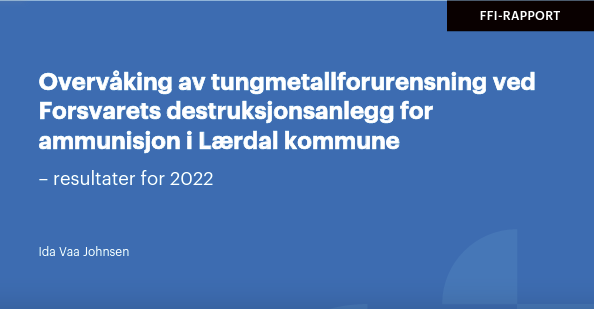In accordance with an agreement with the Norwegian Defence Logistics Organization (FLO), the Norwegian Defence Research Establishment (FFI) monitors and performs chemical analysis and assessment of soil and water samples taken at the Armed Forces demolition facility for munitions in Lærdal municipality. Briefly, the risk to humans and local fauna is low, but FFI will keep on monitoring the area.
By Ida Vaa Johnsen (FFI)
An annual monitoring is conducted in order to document the degree of metal pollution in the two areas where demolition is carried out.
In this report, the results from the monitoring of heavy metal pollution in 2022 are presented. This work follows up and supports the Norwegian Defence Sector’s climate and environmental strategy’s goal of having an overview of sources of pollution and ensuring that pollution of water and soil is monitored and minimized.
In Øyradalen southeast of Lærdal center, the Norwegian Armed Forces has a demolition facility demolishing munitions by open-air detonation.
In addition to the facility in Øyradalen, a destruction facility for small arms munitions and propellant is localized in Tønjumdalen. The destruction of such munitions takes place in an incinerator connected to a treatment plant.
In 2008, FFI recommended that this area should be included in the monitoring program. The concentrations of copper in the demolition area in Øyradalen were higher than at the reference station in the valley. The mean concentration of copper in the demolition area was 516 mg/kg in 2022.
This concentration was slightly lower than the concentration measured in 2021 (575 mg/kg). Zinc, lead, cadmium, chromium and nickel levels were also above background levels in some of the sampling points. It is unlikely that the grazing animals at the demolition area is at risk for poisoning, but due to locally high copper concentrations, it cannot be excluded. In the river Nivla, which runs through the demolition area, the concentration of copper and lead did not exceed the limit values for toxic effects (7.8 μg Cu/L and 1.2 μg Pb/L) in any of the sampling points.
Based on measured concentrations in Nivla in 2022, effects on aquatic organisms is negligible. The concentrations of lead in soil near the destruction facility in Tønjumdalen were above background levels (>60 mg/kg), while the concentrations of other heavy metals were comparable with the background levels (100 mg Cu/kg, 200 mg Zn/kg, 1,5 mg Cd/kg, 60 mg Ni/kg and 50 mg Cr/kg).
The measured lead concentration in the soil in 2022 was on the same level as previous years. Still, the contamination level in Tønjumdalen was within the national limits for recreational areas, and no risk for health or grazing animals is expected. The concentration of munitions-related metals in the river Kuvella in Tønjumdalen (25 μg Pb/kg and 57 μg Zn/kg) were above the limit for toxic effects of aquatic organisms in freshwater (AA-EQS) (1,2 μg Pb/L and 57 μg Zn/L) in one sample, and effects on aquatic organisms cannot be excluded.
Based on the occurrence of metals in soil and water samples from Øyradalen and Tønjumdalen in Lærdal, FFI assesses that the risk to humans and local fauna is low, but that it cannot be excluded. FFI therefore recommends that these areas are not used as grazing areas for animals and that the areas are still to be monitored.
The full report is available for download here, Norwegian language only: https://ffi-publikasjoner.archive.knowledgearc.net/bitstream/handle/20.500.12242/3220/23-01408.pdf
